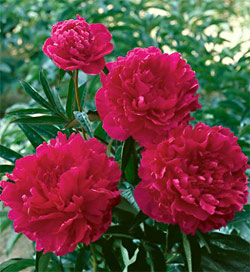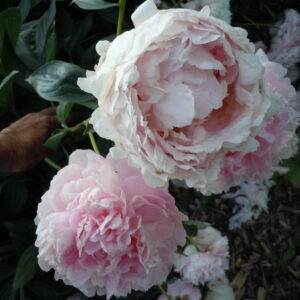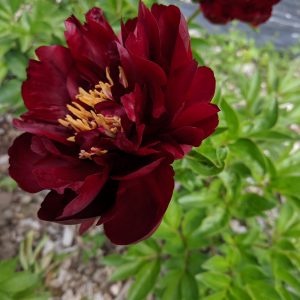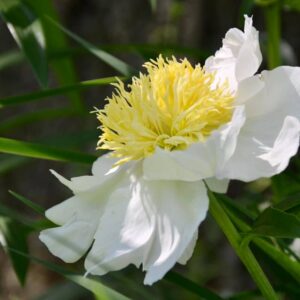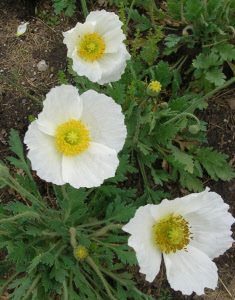Perennials & Biennials
Showing 321–328 of 485 results
-
Paeonia ‘Felix Crousse’ Z 3-8
Fragrant dark pink double blooms in mid-spring
Fragrant dark pink double blooms in mid-spring
Size: 28 x 28
Care: Full sun in moist, well-drained soil, protect from strong winds
Awards: Received England’s Royal Horticultural Society Award of Merit.Paeonia is derived from the Greek mythical figure Paeon, physician to Pluto who cured Pluto after his defeat by Hercules. In thanks Pluto turned Paeon into a flower. Peonies have been in cultivation since Greek and Roman times. Theophrastus, a student of Socrates, described the peony around 300 B.C.. Dioscorides, writing in the 1st century A.D., claimed the root eased the pain of childbirth. During the Middle Ages peony was used in Europe both for food and medicine. Sent from the European continent to England in 1548. Nicholas Culpepper, in The Complete Herbal & English Physician, lists ailments which various peony parts remedied: the falling sickness, cleaning women after child birth, nightmares, and melancholy. The “surest way” to effect a cure was to hang fresh root around the neck. Otherwise an infusion should be taken before and after a full moon
-
Paeonia ‘Karl Rosenfield’ Peony Z 3-8
Double deep carmine blossoms in mid-season
Double deep carmine blossoms in mid-season
Size: 28-32” x 28-32”
Care: Full sun to part shade moist well-drained soil, protect from strong windPaeonia is derived from the Greek mythical figure Paeon, physician to Pluto who cured Pluto after his defeat by Hercules. In thanks Pluto turned Paeon into a flower. Peonies in cultivation since Greek and Roman times. Theophrastus, a student of Socrates, described the peony around 300 B.C.. Dioscorides, writing in the 1st century A.D., claimed the root eased the pain of childbirth. During the Middle Ages peony was used in Europe both for food and medicine. Nicholas Culpepper, in The Complete Herbal & English Physician, lists ailments that various peony parts remedied: the falling sickness, cleaning women after child birth, nightmares, and melancholy. The “surest way” to effect a cure was to hang fresh root around the neck. Otherwise an infusion should be taken before and after a full moon. P. ‘’Karl Rosenfield’ introduced by Rosenfield in 1908.
-
Paeonia ‘Sarah Bernhardt’ Peony Z 3-8
Huge, frilly pastel pink blossoms late in the season, fragrant
Huge, frilly pastel pink blossoms late in the season, fragrant
Size: 36” x 36”
Care: sun to part shade in moist well-drained soil. Plant "eyes no deeper than 1-2" below soil level
Awards: Royal Horticultural Society Award of Merit.Paeonia is from Greek mythical figure Paeon, physician to Pluto who cured Pluto after his defeat by Hercules. In thanks Pluto turned Paeon into a flower. Peonies in gardens since ancient Greece. P. ‘Sarah Bernhardt’ introduced by French nursery Lemoine in 1906.
-
Paeonia lactiflora Buckeye Belle Z 3-8
Semi-double, velvety blossoms of the deepest red, almost chocolate, with large outer petals surrounding narrow inner petals sprinkled with sparkling golden staminodes.
Semi-double, velvety blossoms of the deepest red, almost chocolate, with large outer petals surrounding narrow inner petals sprinkled with sparkling golden staminodes.
Size: 18-24” x 24-30”
Care: Full sun or part shade in most, well-drained soil
Wildlife Value: Deer and Rabbit resistant, attracts butterflies & hummingbirds, great cut flower
Awards: American Peony Society Gold Medal, American Peony Society Award for Landscape MeritHybridized in the USA in 1956 by Walter Mains
-
Paeonia lactiflora x Jan Van Leeuwen Z 3-8
Fragrant cupped single white blooms with yellow stamens
OUT OF STOCK
Fragrant cupped single white blooms with yellow stamens
Size: 2' x 3'
Care: Full sun in moist well-drained soil. Deer and rabbit resistant
Native: Japan
Wildlife Value: birds and ants enjoy the sweet nectar on the buds before openingIntroduced in 1928
-
Papaver anomalum alba Z 5-9
Paper thin petals on this pure white poppy with yellow stamens blooms May to October except in the heat of July.
Paper thin petals on this pure white poppy with yellow stamens blooms May to October except in the heat of July.
Size: 12” x 8”
Care: sun to part shade in well-drained soil. Deer resistant
Native: European AlpsAnomalum means extraordinary and this poppy is. Collected by 1909.
-
Papaver bracteatum Great scarlet poppy Z 5-8
Glossy fire engine red petals with black heart
OUT OF STOCK
Available for purchase in Spring only
Glossy fire engine red petals with black heart in June. D.M. Ferry Catalog, 1876: ”great beauty and magnificent.”
Size: 3-4’ x 3’
Care: sun in well-drained soil. Foliage dies back in summer & reemerges in the cool autumn. Drought tolerant and deer resistant.
Native: Siberia & Northern IranPapaver bracteatum was introduced to European gardens in 1817 from its native Siberia. Poppies have been grown since at least the time when Homer wrote the Illiad, in which he used the poppy’s hanging bud as a metaphor for a dying soldier. During World War I, Canadian soldier John McCrae again united the poppy with dying soldiers. He wrote “In Flanders’ Field.”
-
Papaver orientale Poppy Z 2-7
The classic poppy - papery tabasco petals with black blotch center in June. D.M. Ferry Catalog, 1876:"great beauty and magnificent.” It appears to die back in summer then the leaves reappear in fall.
Available for purchase in Spring only
The classic poppy – papery tabasco petals with black blotch center in June. D.M. Ferry Catalog, 1876: ”great beauty and magnificent.” It appears to die back in summer then the leaves reappear in fall.
Size: 2-3’ x 2’
Care: Full sun in well-drained soil.
Native: Caucasus
Wildlife Value: Deer resistant.Poppies have been grown since at least the time when Homer wrote the Illiad, in which he used the poppy’s hanging bud as a metaphor for a dying soldier. During World War I, Canadian soldier John McCrae again united the poppy with dying soldiers. He wrote “In Flanders’ Field.”
French botanist Joseph Pitton Tournefort (1656-1708) discovered this in Armenia in 1714 and sent it to the King of France. In 1741 Englishman Peter Collinson sent seeds to John Bartram who cultivated the plant in his Philadelphia nursery. Jefferson grew the oriental poppy at Monticello and Washington grew it at Mount Vernon. Acc’d to the Gardeners Dictionary, 1768 “There are two or three varieties of this which differ only in the colour of their flowers … and a double flower of this kind … Tournefort says, the Turks eat the green heads of this Poppy, although they are very bitter and acrid.”

